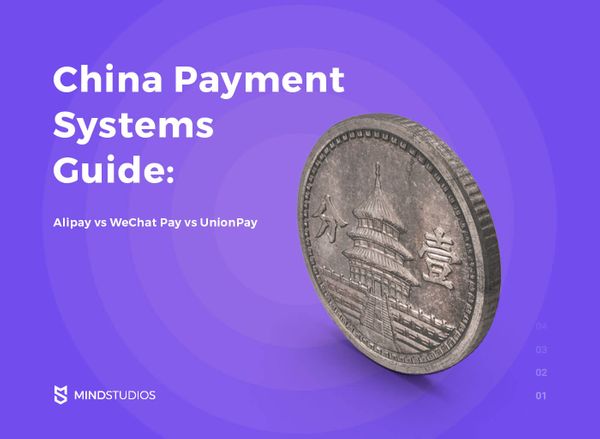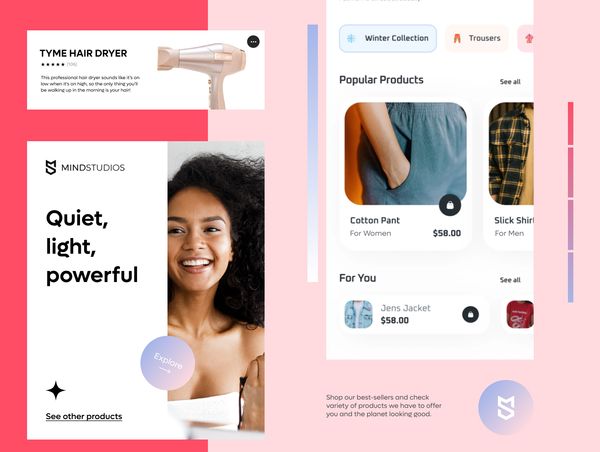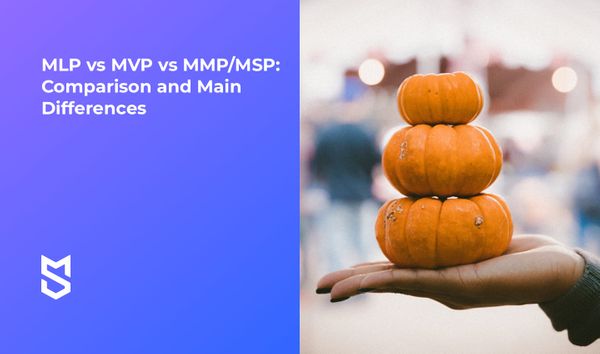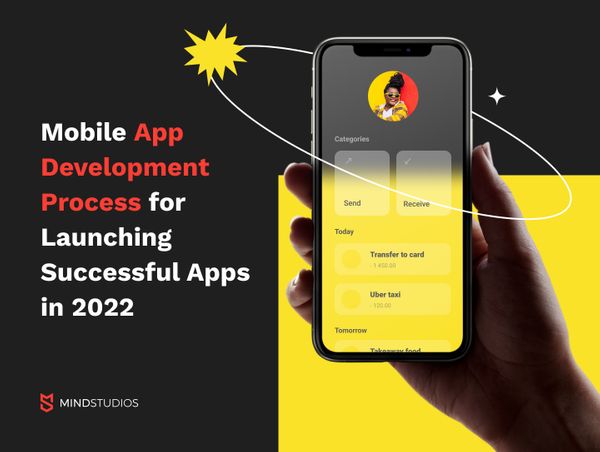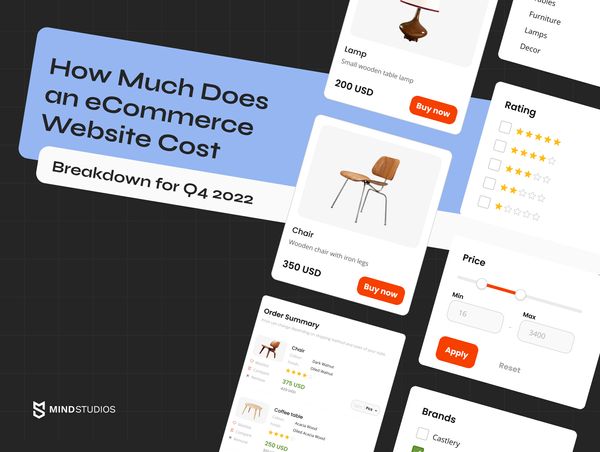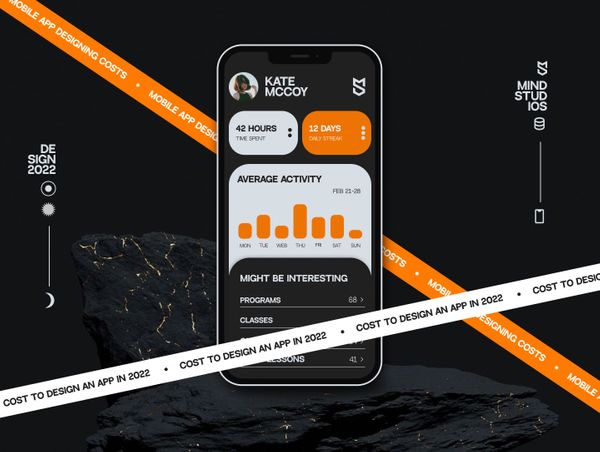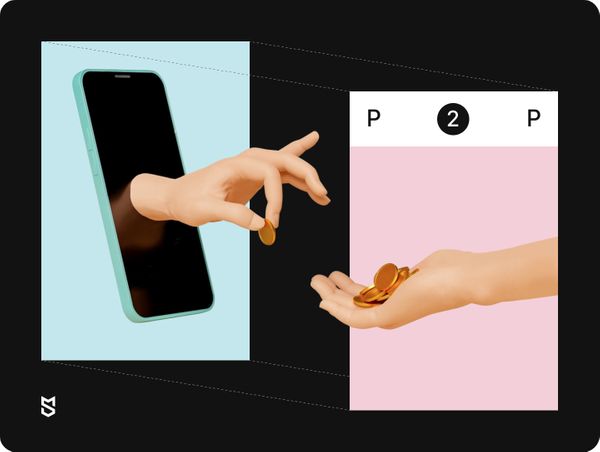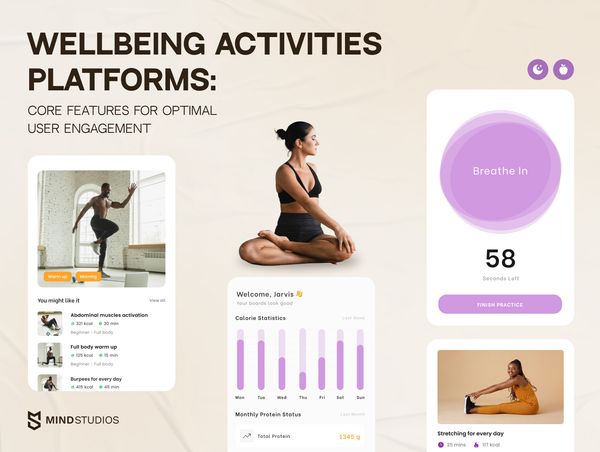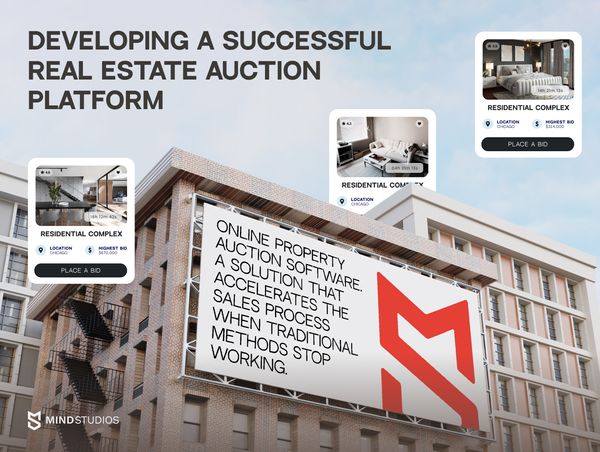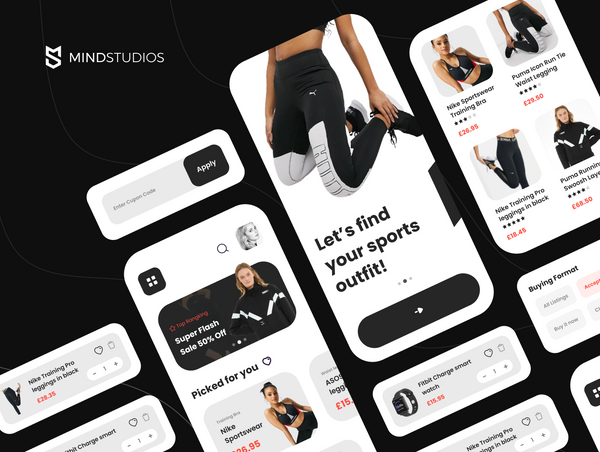
Shopping online has never been easier: all one has to do is download the app, make a few scrolls and taps, and wait for the order to get shipped. So, it’s no wonder that mobile commerce, with its “one-click purchase” and “quick checkout” options, is rapidly outnumbering other types of eCommerce.
According to GlobalData, mCommerce transactions from all around the world reached $2.8 trillion in 2021 and are expected to reach $4.9 trillion by 2025. What is more, in 2021, global mCommerce’s share of all eCommerce sales was 52.7%.
So, how can retailers and marketplace owners benefit from this trend?
In this article, we walk you through each stage of mCommerce app development, provide a cost estimate, and share tips on how to make your platform captivate your target audience.
Mobile commerce market size
Shopping has been gradually moving online for years, but 2020-2021 — and the global pandemic in particular — has given it a big push. According to the eMarketer report on global eCommerce growth, eCommerce sales are expected to exceed $5 trillion by the end of 2022. Moreover, total spending on eCommerce platforms will go past $7 trillion by 2025.
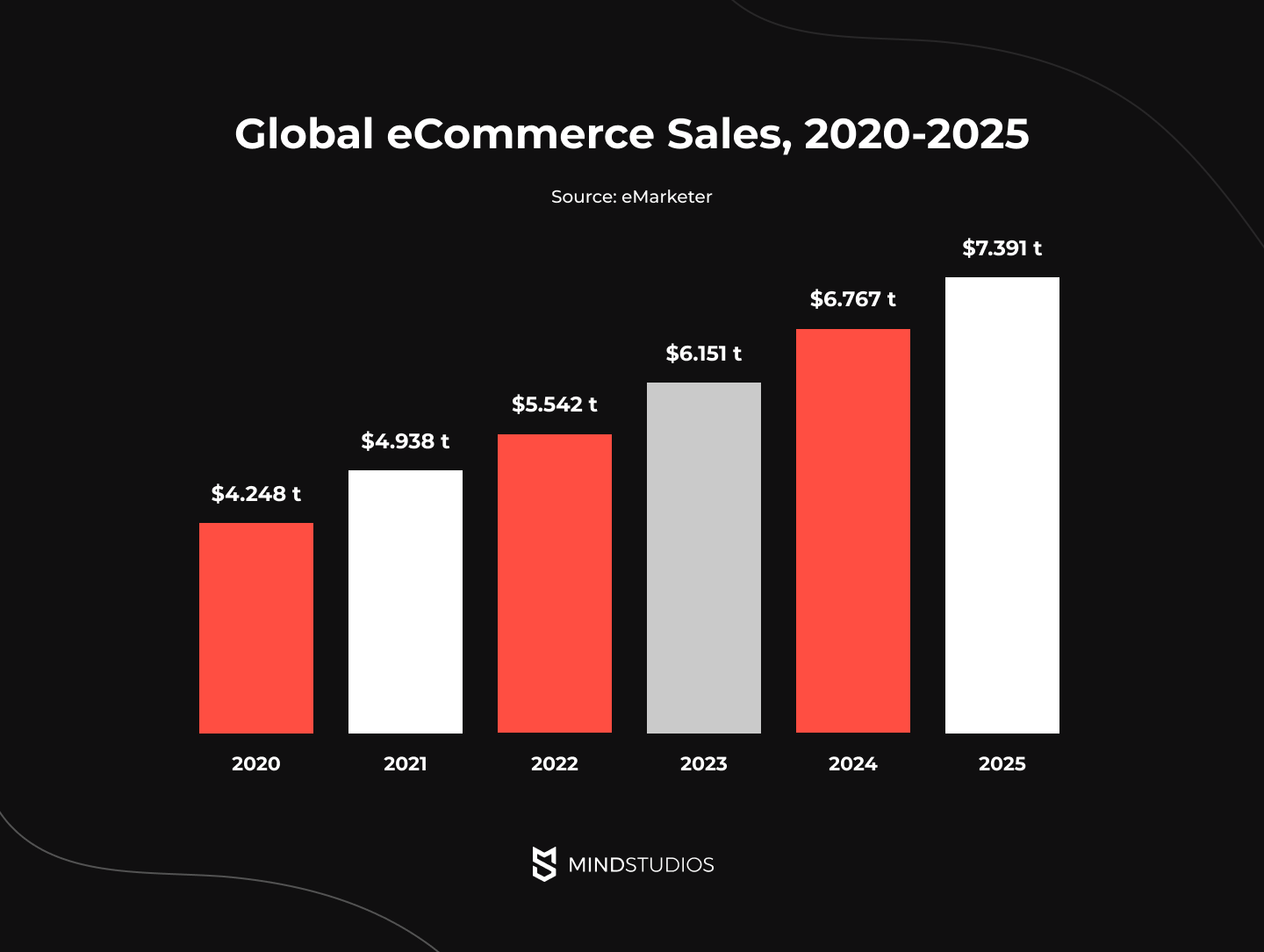
So, what's mCommerce's share in these statistics? As stated by Insider Intelligence, retail mCommerce sales reached $359.32 billion in 2021, which shows a 15.2% increase compared to the previous year. The same source predicts that in 2024, mCommerce volume will reach $620.97 billion.
The primary reason for these numbers lies in the overwhelming presence of smartphones in our everyday life and all the perks that come with them, such as digital payments. Amazon Pay and PayPal in the US, Apple Pay and Google Pay in Europe, and Alipay in China — all these digital payment systems helped turn shopping via mobile apps into a seamless experience.
Both traditional and mobile eCommerce are on the rise, and ignoring this fact spells disaster for businesses. Now’s the best time for making an eCommerce mobile app.
Advantages of having a mobile eCommerce app
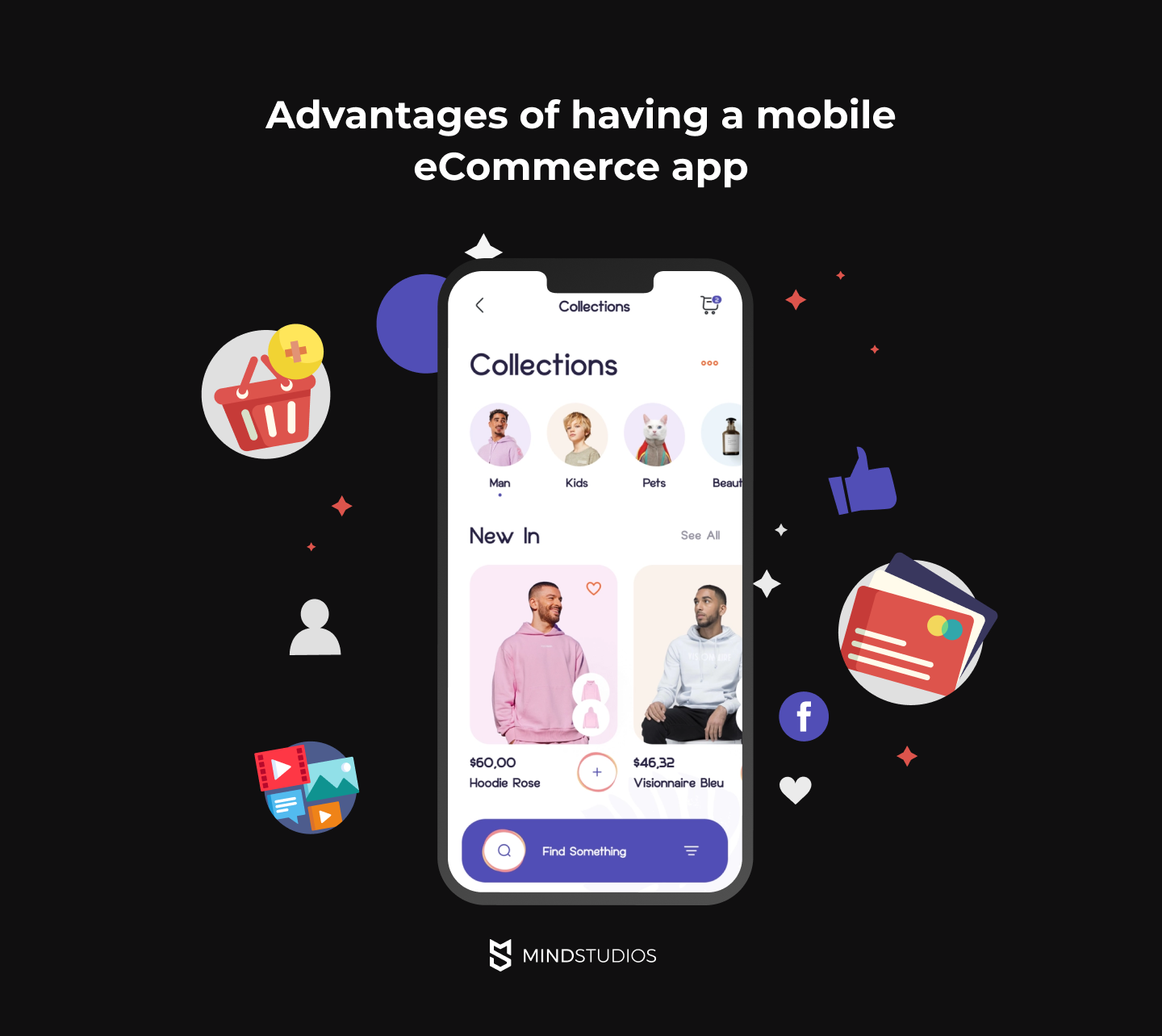
While most business owners understand the crucial importance of an online presence, there are advantages to having a mobile platform in particular that not everyone is aware of.
Here are 4 reasons why having a mobile eCommerce app can significantly boost your business.
- Mobile apps are always at hand. The biggest perk of having a mobile app is that your customers can open it when the need arises and make purchases instantly.
- Mobile apps can access a device’s hardware-based functionality. Unlike most web apps, native mCommerce apps provide users with the opportunity to make a purchase via a voice assistant, which is a big perk for busy buyers and for people with limited hand mobility. Then there are barcode readers that make it easy to compare prices or get additional information on items. Finally, there are modern AR/VR features, which, for instance, allow customers to see how items will look in their home’s interior, for example.
- Mobile apps are faster than websites. Faster frameworks, as well as better integration with the device hardware, make mobile apps almost twice as fast as your regular website. Another benefit of mobile apps is the ability to store data locally on the device, which both speeds up operations and allows mobile apps to work offline.
- Mobile apps provide a personalized customer experience. According to the survey by information technology company Accenture, 91% of consumers are more likely to purchase products from brands that “recognize, remember, and provide relevant offers and recommendations”. Mobile apps allow business owners to implement features that are tailored to their customers’ needs. This includes personalized recommendations, relevant push notifications, etc.
These are only the most significant benefits of making an eCommerce mobile app, but they’re not the only ones. Mobile apps are more convenient for users. They offer higher availability, a more diverse range of payment options, and greater flexibility. Depending on your business, a mobile app can also give you an edge in the market.
Features an mCommerce app needs

Developing a mobile eCommerce application is challenging. An m-Commerce app needs lots of features, and with the number of stores going online these days, you need to stand out from the crowd.
This means you need to thoroughly analyze both your competitors and potential customers. You’ll need to research what’s lacking in the industry and where it’s oversaturated, what your target audience needs, and what it’s fed up with.
After that, you should work with an m-commerce app development company to create a list of features to include in your app. Here’s our take on a list of essential features of an m-commerce app.
| Feature | Description |
|---|---|
| Onboarding | When a user opens your mCommerce app for the first time, you need to show them where the main features are. Onboarding should be as short as you can make it without sacrificing clarity. It’s also a good idea to make it fun: use animations and friendly language to lighten the mood. |
| Sign-up/sign-in | Make registration and authentication as quick and easy as you can. Integrate registration and authentication via Apple, Facebook, and Google accounts for swiftness. |
| User profiles | User profiles let users store their payment information and delivery addresses (or devices, if you’re selling digital items). Users will also want to access their purchase histories, wish lists, and settings, and the most user-friendly way to do that is to add links to the user profile. |
| Items list | This is where you can display all the products you sell. It’s the heart of your whole store, so it needs to look appealing and contain quick links to each product page. |
| Product screen | Create a separate screen for each product you sell, with quality images, product descriptions, product characteristics, and reviews. |
| Product comparison | This feature enables users to make the best decision based on the price and characteristics of the product. You can implement different filter methods depending on the items’ category. For instance, for electronics, the comparison will include technical characteristics. |
| Search functionality | Add autocomplete suggestions to your search feature to make it more convenient for users. Advanced search might include categories, price ranges, or other distinctive characteristics of your products. |
| Filters | Filters narrow down selections, helping users find what they need quicker and making the user experience more satisfactory. |
| Wishlist/favorite items | Let users add items they might want to buy later to a wishlist or favorites list. |
| Waitlist | Items on the waitlist are out of stock but can be restocked if there’s demand. A waitlist might help you learn more about popular and in-demand items as well as retain customers you might have otherwise lost to competitors. |
| Cart | The cart holds items before and during checkout. |
| Easy checkout | This feature relieves users from the need to type in the same, often excessive, information over and over again each time they make a purchase. |
| Payment options | The variety of payment systems today is astonishing — credit cards, PayPal, Google Pay and Apple Pay, Bitcoin — and people want to use whatever they find most convenient. The more payment options you offer, the better. |
| Push notifications | Push notifications get way more user engagement than email or other kinds of messages when it comes to reminding users about abandoned carts, restocked items, discounts, or any news about your store. |
| Social media integrations | Allow your customers to share their purchases, wish lists, and reviews to Facebook, Twitter, and other social networks. This will increase your business’s visibility and user engagement. |
| Ratings and reviews | Reviews do two things:
|
| Recommendations | There are three types of recommendations when it comes to retail:
|
| Promoted items | If you’re making an eCommerce mobile app for a marketplace startup, consider adding opportunities for sellers to promote their items. This will provide you extra revenue. |
| Coupons and promo codes | Shoppers love discounts. You can offer coupons as rewards and promo codes tied to holidays or your store’s milestones. |
| Admin panel | This is a place where you or a designated employee can add/remove content, monitor app activity, and control payments. |
| Customer support | Customer support can be implemented via an in-app chatbot using machine learning if you don’t have a support team working around the clock. |
| Retail locations | If you have brick-and-mortar stores, putting their locations in your app is a sensible decision. You can also help users navigate to your stores via built-in maps. |
| Analytics | Advanced analytics tools will help you with your business and marketing strategies. To be more specific, it allows you to gather valuable insights by seeing which products or brands sell best, how and when users interact with the app, why they leave the app, etc. |
Technologies worth using in mCommerce
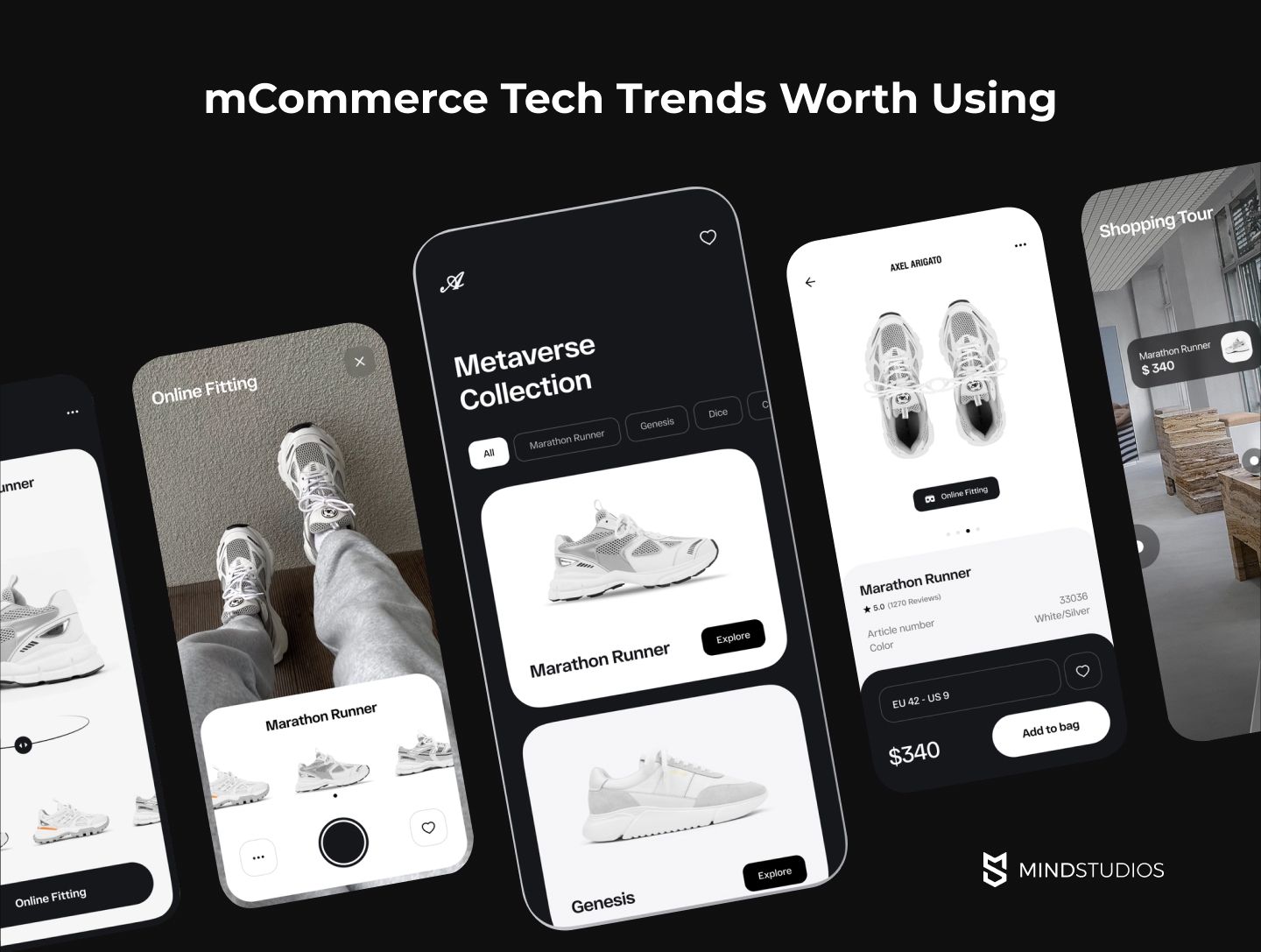
Features that we’ve listed in the previous section make a perfectly good base for an mCommerce platform. However, when it comes to building mobile apps, the sky is the limit in terms of technology. So, if you want to take your game to the next level — here is a list of advanced tech trends that you can use for your mCommerce app.
Big data
Big data is what helps businesses increase customer engagement, and boost sales. How exactly does it work?
Basically, big data tools provide companies with detailed information on customers’ behavior, financial transactions, and the competitiveness of the marketplace. As a result, this enables businesses to enhance the shopping experience on their platform, improve targeted personalization, and even predict future trends and optimize pricing.
For instance, Walmart started using big data back in 2011, when the company integrated a real-time social media search and analysis tool, which helped the company gain user insights. Another example is eBay with its comprehensive data analytics for studying user behavior and ShopBot solution powered by big data, which helps them personalize the shopping experience.
Augmented and virtual reality (AR/VR)
AR/VR features on eCommerce platforms usually serve as a link between online and offline shopping. It enables customers to virtually “try on” items they are thinking of buying, like clothes, beauty products, and even furniture.
In fact, Ikea’s mCommerce platform is one of the most successful examples of retail businesses using AR.
You can read more about their experience in our article “AR apps boost business: How to make an app like IKEA place”.
Artificial Intelligence
AI features are one of the most powerful tools that can help you provide a personalized experience to your customers and therefore, increase sales. To be more specific, here are AI-powered features that are all the rage in the eCommerce industry right now:
- Voice assistant that enables customers to search for needed products quicker
- Chatbots that respond to users’ questions, provide detailed information about the products or order status, etc.
- Visual search that allows shoppers to search for items on your platform by taking a picture via a smartphone
- Pricing optimization that is basically an AI-calculated strategy, predicting when and which products should be discounted to boost sales
- Personalized recommendations for customers based on their purchase history, customer segmentation, and other data collected.
Social media commerce
Social networks like Facebook and Instagram are taking on the role of eCommerce platforms, and for retailers and marketplaces, this means a new opportunity to improve sales.
Basically, you can integrate your products into these social media platforms and allow customers to buy those products directly from those social apps. And it’s high time to do it now, since, according to data published on Statista, the value of social commerce sales can reach around 2.9 trillion U.S. dollars by 2026.
mCommerce payment options
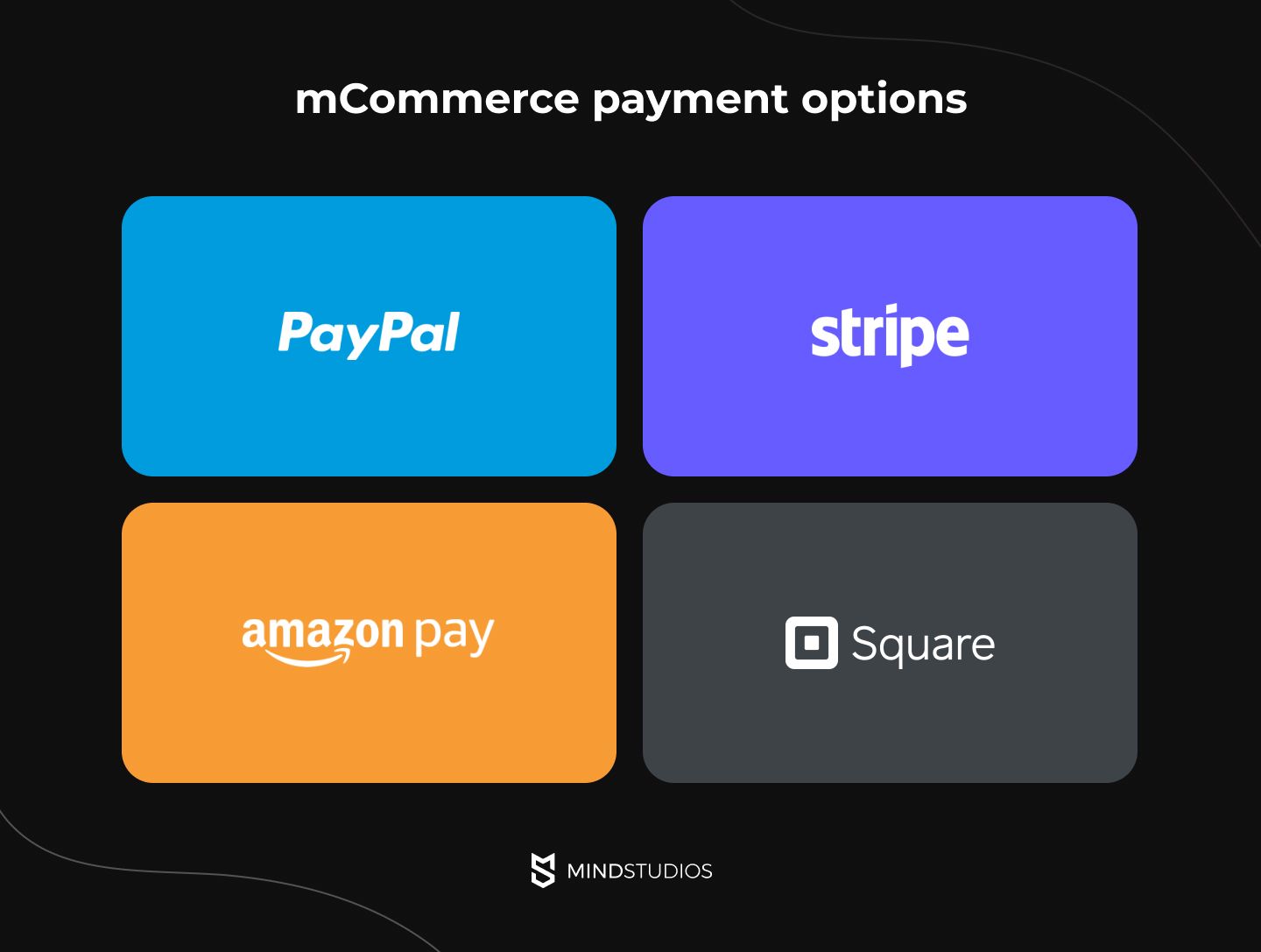
Quick and easy digital payments are one of the reasons shopping via smartphones has become so popular. Therefore, it’s only natural that we’ve decided to look into some of the most common payment options available.
-
PayPal is an online money transfer system with 429 million active user accounts as of the first quarter of 2022. It is available in over 200 countries, handling 25 currencies. Usually, it takes the service one business day to process transactions.
The PayPal transaction fees depend on the nature of the transactions, as well as their type (domestic or international). The amount of money you send each month also influences the fee. As a rule, PayPal’s fees range from 1.9% to 3.5% of each payment and a fixed fee of 49 cents.
On the plus side, the service is highly secure, with its advanced end-to-end encryption, an option of two-factor authentication, and no disclosure of credit card information online.
-
Stripe is an online payment system that offers payment processing software and APIs for e-commerce websites and mobile applications. It is available in 46 countries and used by more than 3 million platforms.
The transaction fee starts at 2.9% plus 30 cents, which is generally less than PayPal charges. However, on Stripe, payouts are made once a week, so you’ll have to wait longer for the money.
Stripe is considered safe, with it using AES-256 encryption, P2PE-ready virtual terminals, and 3D secure authentication for business and developer logins.
-
Amazon Pay is an online payments service that allows users to pay with their Amazon accounts while shopping on external retail websites. While it is most popular with US users and companies, the service is also available in other countries, mostly European ones. One of its biggest advantages is strong fraud protection system.
The processing rate is 2.9% plus 30 cents per transaction for online and mobile payments, and 4% plus 30 cents for Alexa voice payments. Usually, transactions are processed in 3-5 business days.
-
Square is a financial services platform that enables small and medium businesses to accept credit card payments.
While it’s easy to use, it is now available only in the US, Canada, Australia, Japan, the United Kingdom, the Republic of Ireland, France, and Spain.
Square charges 2.9% plus 30 cents for online purchases, including the ones made via e-commerce apps.
In addition to payment gateways listed here, you can also look into other popular options, like Google Wallet, Skrill, Adyen, or Braintree. However, keep in mind that sometimes your particular project might need a different out-of-the-box solution. For instance, Mind Studios once had to cooperate with a Danish bank because it was the best option for the project.
When we were developing James Butler, a food delivery app for the Danes, we faced a problem with Stripe. The system didn’t support instant payments in several countries, including Denmark, and that was not an option.
So, after researching our options, we decided to work with Danske Bank, who offered us to use the Single Euro Payments Area (SEPA) protocol to process instant payments. However, this option required some code upgrades, so our developers ended up polishing this Ruby-written solution. As a result, we managed to integrate a smoothly running instant payment system into the app.
Setting up a shopping cart for a mobile commerce app
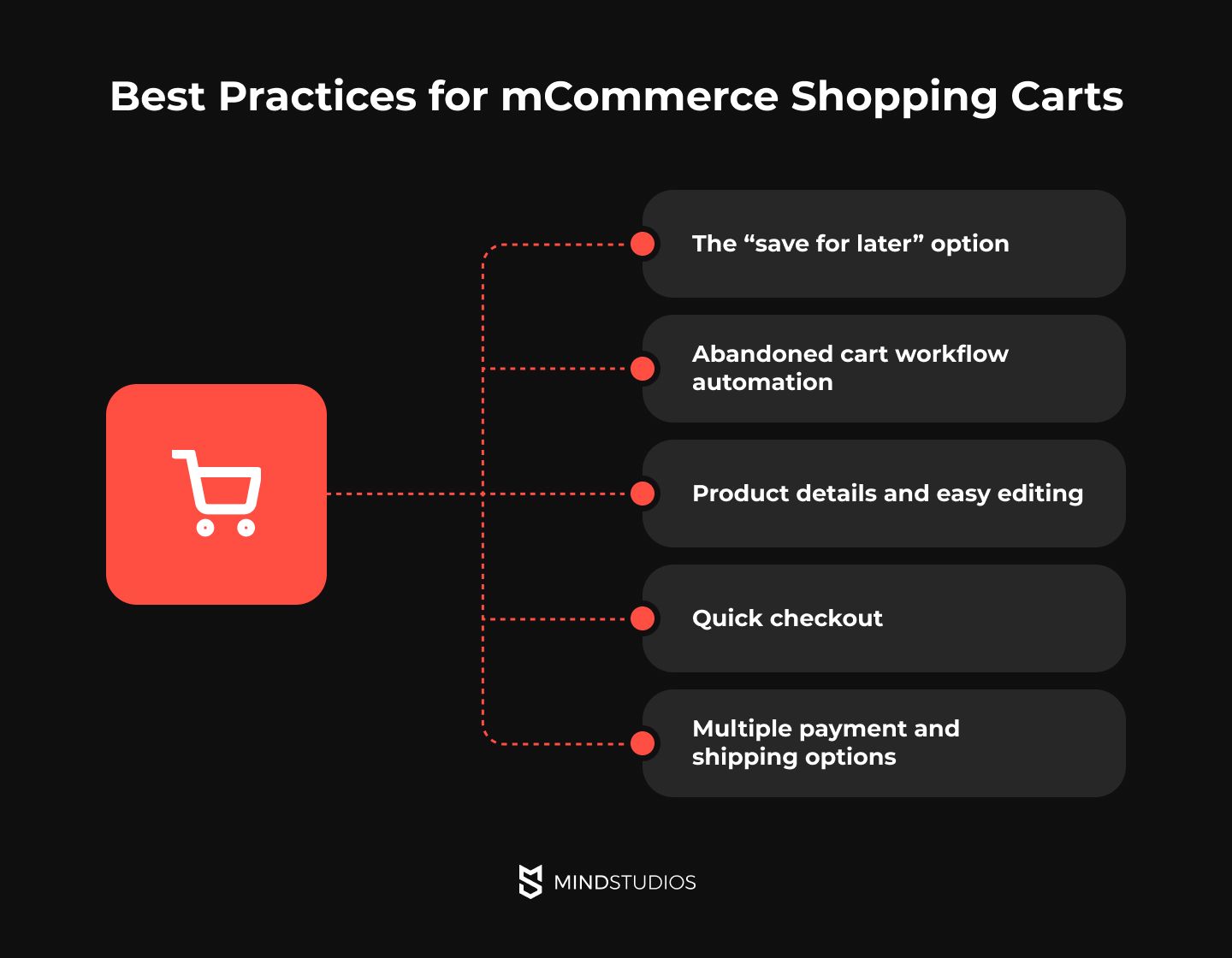
The better and more thoughtful the shopping cart UI/UX design, the smaller the gap between the app traffic and actual conversion rate. Too many distractions or forms to fill out — and the user will find an easier way to purchase the selected items. Therefore, shopping carts are a crucial point when it comes to the development of mCommerce apps.
Let’s take a look at the most successful practices out there used to create this element of the app.
The “save for later” option
Adding items to a shopping cart does not necessarily mean users want to buy them right away. You can give them the option of saving the items for later by creating a “favorites” or a “save for later” section. You also need to make sure that the items won’t disappear from the shopping cart if the user closes the app.
Abandoned cart workflow automation
You can’t totally avoid users leaving the shopping cart, but you can make sure the customer journey doesn’t end there. To remind users of the items in their cart, you can use email reminders, push notifications, retargeting advertisements, and even encourage them with coupon codes and limited-time offers.
To make these tools even more effective, use analytics tools to determine when your audience is most likely to open the app.
Product details and easy editing
To make shopping easier for your customers, make product descriptions available in the shopping cart. This way, there will be no need to go to another page, and therefore, there will be less chance of cart abandonment. The descriptions can be brief and contain the most significant information.
In addition, you can enable users to edit their shopping cart without leaving the page: for instance, change the color of the shoes they added or quickly switch that smartphone to the same model but with bigger storage.
Quick checkout
Probably, the most important thing with checkout is to make it as seamless as possible. If possible, avoid requiring to create an account to make an order or asking for too much information.
Instead, give users an option of signing up via their Google or Facebook account. According to a report by the US National Retail Federation, 97% of cart abandonment happens because of inconvenience. So, the key here is to keep it simple.
It is also recommended to use breadcrumbs with progress indicators for the checkout process. This way, even if the process takes a few steps to complete, the users know exactly how many steps there are and therefore, are less likely to abandon the cart.
Multiple payment and shipping options
The more options there are, the higher the chances of users going through with the checkout. If it’s a matter of payment, provide users with various options, like paying with a digital wallet, a credit card, a debit card, or a bank transfer.
If it’s the shipping block, let them choose the best option by cooperating with multiple delivery services, with a cost estimate for each one of those.
What to pay extra attention to when making an eCommerce mobile app
Some steps in the mobile commerce app development process require an extra careful approach. In this section, we’ve collected the most crucial of those.
Security
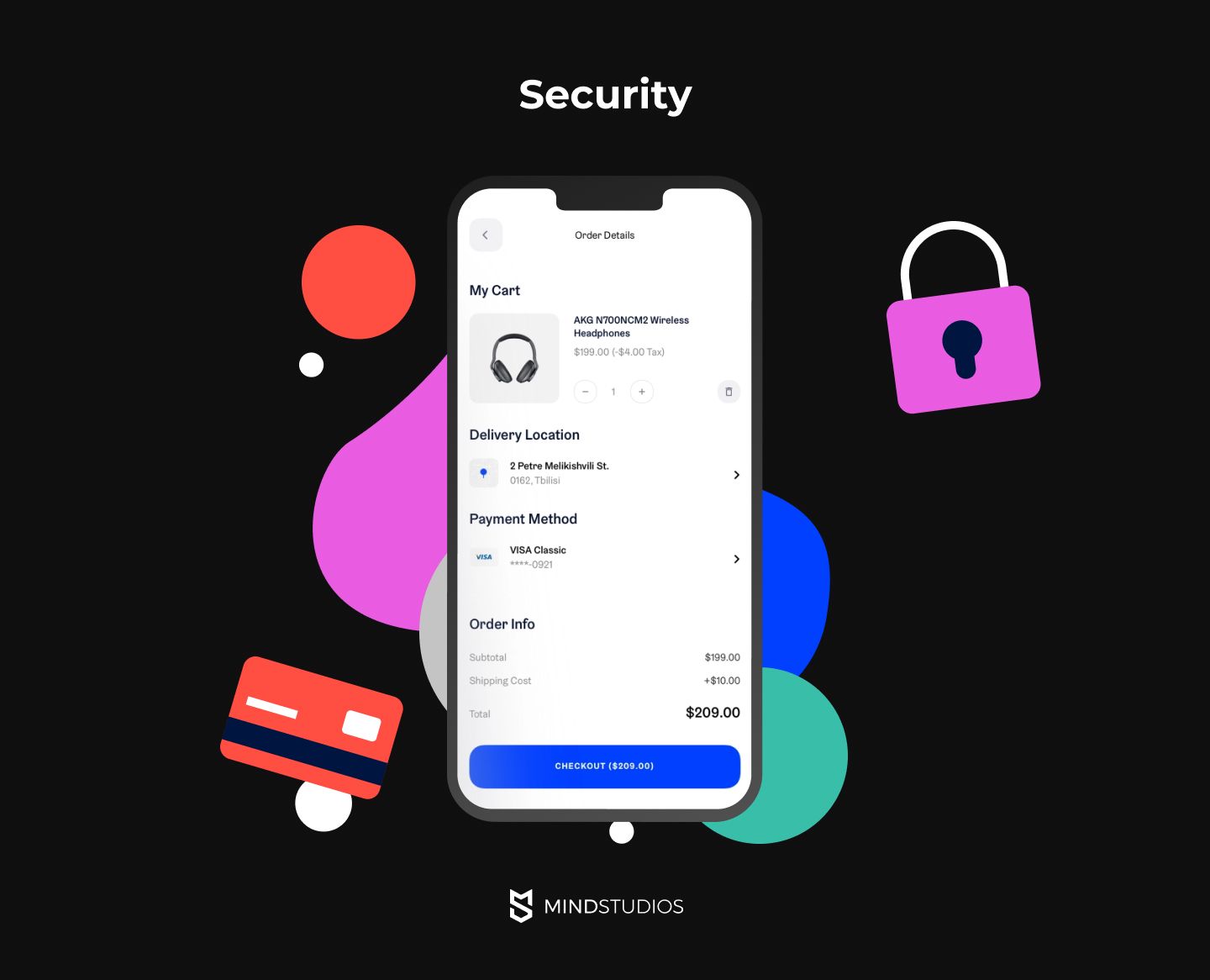
When selling things online, a major concern is the security of your buyers’ financial and personal details. Poor security can cause irreparable damage to your business’s reputation.
Additionally, without proper security measures, you can forget about getting your app on an app store. With cybercrime being one of the biggest dangers in today’s world, both the App Store and Google Play take measures to ensure all apps meet certain security criteria.
What can you do to meet those criteria?
- End-to-end encryption is a must. Any sensitive information must be encrypted when stored and thoroughly protected.
- Offer two-step authentication: email + password or a PIN followed by a time-limited authentication token delivered via text message, email, or push notification. These tokens must be encrypted and wiped after they expire.
- Use biometric authentication methods like fingerprint recognition or Face ID, although it’s recommended to complement biometric authentication with tokens, at least when it comes to financial transactions.
- Force additional authentication when a user performs significant actions: checks out, makes changes to personal information, etc.
- Verify and filter user data regularly to ban scammers.
- Only use official APIs from reliable sources.
These are just the most significant points. Take into account that the security measures you take can affect the cost to build your m-Commerce app.
Conversion rate optimization (CRO)
In eCommerce, traditional and mobile alike, your return on investment (ROI) directly depends on your users making purchases. Hence, your ultimate goal is to convert visitors into customers.
The mechanism that does this is called the conversion funnel — a series of stages that lead users to take or not take specific actions: leave their emails to receive promotional newsletters, subscribe to some kind of premium service (can be used in marketplaces), or make a purchase.
You should take your conversion funnel into account from the earliest stages of prototyping. Conversion rate optimization is a set of practices to help you create a user interface that will entice users to complete a purchase.
Usually, CRO relies on the work of UI/UX designers and marketing specialists, but developers can be invited to build prototypes to test your conversion funnel.
Legal and financial aspects

Selling things online is tricky, especially if you’re doing it internationally. You need to meet various compliance requirements. Some items cannot be sold to certain countries, for example. Countries also have their own preferred payment systems and financial regulations. You’ll need to research the specifics of each country you plan to sell to.
Another issue is selling via a mobile app in particular. If you’re selling digital content — ebooks, media files, items in games — you’ll need to pay a fee to the app stores. Apple takes 30% from in-app purchases, while Google’s fees start at 15%.
If you’re selling physical items you’ll send via mail, your in-app transactions are exempt from this fee, but you’ll need to pay the fee for using the payment system you integrate into your app.
How to develop an mCommerce app step-by-step
Mobile apps are developed in stages. Depending on the scale of your project and how far ahead you’ve planned, developing an eCommerce mobile app can take from several months to a year or so.
If you want to launch as soon as possible but don’t want to sacrifice the quality of your app, you can start by launching a minimum viable product (MVP). An MVP will allow you to test your app’s features and ideas, as well as prioritize features for future mobile commerce app development. Besides, an MVP is an opportunity to start earning while you’re still developing your app. This option, however, is not suitable for all projects.
Regardless of which way you decide to go — MVP or a full product launch — here’s what goes into developing a custom mobile eCommerce app:
1. Discovery
This stage includes:
- Filling in the lean canvas, which means dissecting the app idea into main business assumptions
- Creating a mind map to visualize the structure between the main components of the project
- Building epics lists, which essentially means breaking the project down into tasks
- Creating user personas, detailed portraits of the prospective platform users
- User story mapping, which helps determine how users might interact with the app
- Making the navigation concept
- MVP evaluation
2. Idea validation
At this point, the team is involved in:
- Performing a target audience survey, which can include studying various forums, conducting interviews and surveys, organizing focus groups, and analyzing users’ feedback of your competitors
- Analyzing the market and establishing if there is white space for your idea there
- Making a concept validation prototype
3. UI/UX strategy and design
During this phase, UI/UX designers get down to:
- Building the information structure (ERD diagram)
- Working on UX concepts, which convey the interactions users will have with the app, and UI concepts, which focus on the visual aspects of the app
- Creating high-fidelity prototypes — mockups that demonstrate each of the app screens and connections between them
- Making a refined estimate
- Finalizing an approximate project plan (Gantt chart)
4. Development, testing, and deployment
This final stage includes:
- Android and/or iOS development
- Building the server-side (API) of the application
- Testing the application for any bugs and reporting to the development team
- Fixing the bugs and launching the application
Usually, research and initial mobile commerce app design can be done simultaneously to save time and effort. If you’ve conducted thorough research on your own, you can cut some time typically spent on research by the development team. However, we still recommend allocating time with your m-commerce app development company to verify data, since new information might emerge during negotiations.
One of the questions you’ll need to answer before starting mobile commerce application development is which platform to launch on. These days, most eCommerce mobile apps are developed for both iOS and Android to reach more customers. This is, of course, more expensive than launching for only one platform, as code for Android and iOS is vastly different.
To cut costs, you can opt to launch for one platform first and the second one later. Your research will show you which devices your target audience uses most.
How much does it cost to make an m-Commerce app?

The cost of developing an mCommerce app is never set in stone, since it depends on too many factors. There’s the number and complexity of m-commerce app features you need — that will have the biggest influence on the cost.
Technologies like AR and certain APIs might cost quite a bit. The intricacy of the design is the second most important factor: a fancier interface takes longer to create and adapt to different screens. Then there’s the hourly rate of your app outsourcing company and the number of specialists you decide to hire.
As this is a general-purpose article, we’ll offer an estimate for a minimum team and a set of core features.
Here’s the minimum team:
- 1 project manager
- 1–2 UI/UX designers
- 1 iOS developer
- 1 Android developer
- 1 backend developer
- 1–2 QA specialists
Based on the number of specialists involved and an hourly rate of $45, you can expect the time and cost estimate to look similar to this:
| Stage | Time (hours) | Cost (USD) |
|---|---|---|
| Discovery stage | 80–100 | 3,600–4,500 |
| UI/UX design | 120–200 | 5,400–9,000 |
| Android development | 420–540 | 18,900–24,300 |
| iOS development | 420–540 | 18,900–24,300 |
| Back end + admin panel | 320–460 | 14,400–20,700 |
| Quality assurance & project management | 180–240 | 8,100–10,800 |
| Total | 1,540–2,080 | 69,300–93,600 |
With this time estimate, the cost to build your mobile commerce app will be approximately $69,300 to $93,600 for core features.
The time it will take to launch such an app is about half a year. Implementing complex features like AR will impact both the time and cost, but you can postpone these features if need be.
Afterword
We buy and sell not just on Amazon and eBay but on Instagram, Facebook, and other mobile-first platforms. Mobile technology makes it way faster, easier, and more convenient to buy using mobile devices. The security of mobile apps is also catching up fast with the security of web stores.
Surely, there already are lots of superior mCommerce platforms on the market. However, your idea has every chance of making it, as long as you find a skilled team to come up with tech solutions and help you strengthen your business.
We hope that after reading this article, you have a basic understanding of how to develop an m-commerce app.
If you want to discuss a specific idea and find out how much its implementation can cost, don’t hesitate to contact us. Mind Studios’ business development team will be happy to arrange a free 45-minute consultation and answer any questions you might have.

